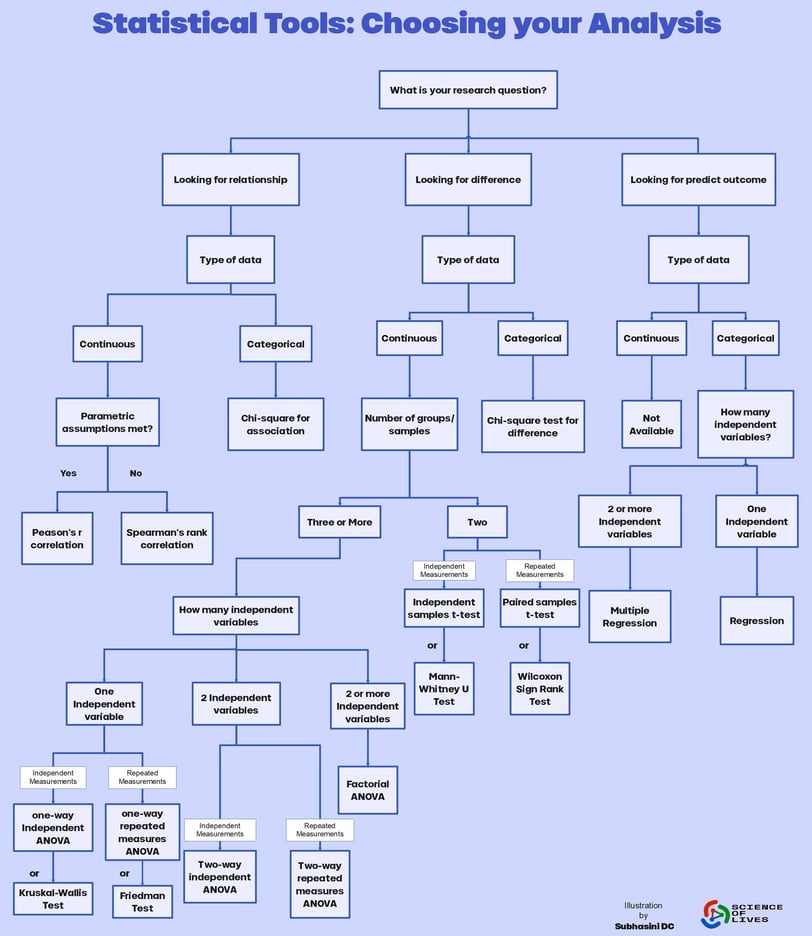From Data to Discovery: A Comprehensive Guide to Statistical Analysis
The term statistical analysis refers to the process of collecting, organizing, and examining data to identify patterns, trends, and relationships. Statistical analysis is the backbone of all research areas. It lets researchers change from simply collecting data towards unveiling the underlying truths and making significant contributions to their area of research. Statistical analysis forms an integral part of research that guides researchers throughout their journey. It transforms raw data into knowledge, strengthens research conclusions, and ultimately paves the way for advancements in various fields. Statistical analysis includes the following
Hypothesis Testing: Research often starts with a hypothesis - What one proposes to explain an observation. Formulate a null hypothesis (no effect) and an alternative hypothesis (an effect exists). Choose a suitable test depending on type of data (e.g., t-test for comparing means or chi-square test for categorical data). In a water treatment study, the null hypothesis - a new filter does not affect bacterial levels, while the alternative hypothesis - the filter reduces bacteria. For comparison of treated and non-treated water bacteria levels, it would use a t-test. A low p-value (typically less than 0.05) indicates that the observed difference is unlikely due to chance, supports the alternative hypothesis (filter effectiveness).
Right Statistical Tool: Choosing an appropriate statistical tool for the study is also significant in analysing the data. The right choice statistical test is taken as a part of the process in any research work. If it fails to go through, there might be chances that the conclusion reached out will also be wrong. It again decreases the reliability of the findings. A few things that should be kept in mind
Data type: Numerical (continuous or discrete or categorical).
Number of groups: One, two, or multiple groups.
Research question: Comparing means, determining relationships, or analyzing frequencies.
Some of the common statistical tests include
T-test: Used to compare the means of two groups.
Independent t-test: For independent groups (e.g., treatment vs. control)
Paired t-test: For dependent groups (e.g., before and after measurements)
ANOVA (Analysis of Variance): A test for the comparison of means of more than two groups.
Chi-square test: This is a test to analyze categorical data to check if there's a relationship between variables.
Correlation analysis: It is used to measure the strength and direction of the relationship between two continuous variables. Types of Correlation Coefficients:
Pearson correlation coefficient: Measures the linear relationship between two continuous variables.
Spearman correlation coefficient: Measures the monotonic relationship between two variables (not necessarily linear).
Regression analysis: Used to predict a dependent variable based on one or more independent variables.
Simple linear regression: One independent variable.
Multiple linear regression: Multiple independent variables.
Logistic regression: Categorical dependent variable.
Model Diagnostics
For checking the appropriateness of your model, you can follow the diagnostic checks
Residual Plots: for checking randomness and homoscedasticity.
Q-Q Plots: to check the normality of residuals.
Scale-Location Plot: to check homoscedasticity.
Multicollinearity Check: Using Variance Inflation Factor (VIF).
Model Assumptions: Confirm linearity, independence, and normality.
Statistical analysis is an indispensable tool for researchers across various disciplines. With good understanding of hypothesis testing, selection of the right statistical tests, and correct data analysis, researchers can discover meaningful patterns, draw reliable conclusions, and contribute to knowledge advancement. Researchers must apply these analysis using statistical software like SPSS, R, or Python while following the right ethics in handling and interpreting data.
To understand more:
Montgomery, D. C., & Runger, G. C. (2014), Applied Statistics and Probability for Engineers (6th ed.). John Wiley & Sons.
Field, A. (2013), Discovering Statistics Using IBM SPSS Statistics (4th ed.). SAGE Publications.
Wasserman, L. (2004), All of Statistics: A Concise Course in Statistical Inference. Springer.


